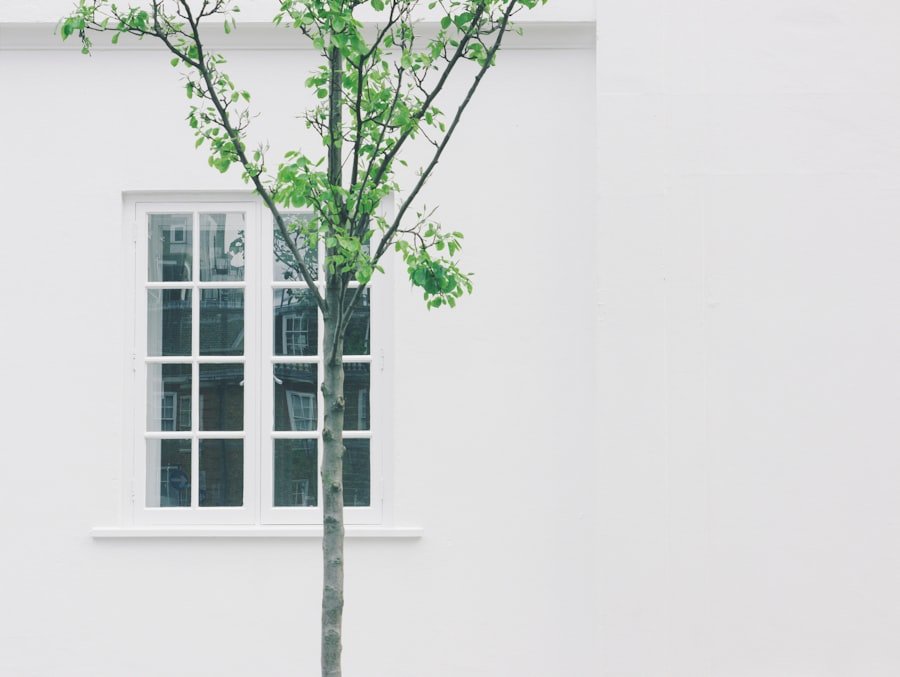This post may contain affiliate links. When you purchase through links on our site, we may earn an affiliate commission.
Japandi style is a design movement that harmoniously blends the minimalist aesthetics of Japanese design with the cozy, functional elements of Scandinavian decor. This fusion creates a unique interior style that emphasizes simplicity, functionality, and a deep appreciation for craftsmanship. The term “Japandi” itself is a portmanteau of “Japanese” and “Scandi,” reflecting the cultural and aesthetic influences that shape this design philosophy.
At its core, Japandi seeks to create spaces that are not only visually appealing but also promote a sense of calm and well-being. The roots of Japandi can be traced back to the principles of Zen Buddhism, which emphasize mindfulness and the beauty of imperfection. This is complemented by the Scandinavian ethos of hygge, which celebrates comfort and warmth in living spaces.
Together, these philosophies encourage a lifestyle that values quality over quantity, urging individuals to curate their environments with intention. In a world often filled with excess and chaos, Japandi offers a refreshing approach that prioritizes serenity and balance, making it increasingly popular among those seeking to create peaceful havens in their homes.
Key Takeaways
- Japandi style is a fusion of Japanese and Scandinavian design principles, combining minimalism, functionality, and natural elements.
- Minimalist furniture and decor are key components of Japandi style, focusing on clean lines, simple shapes, and uncluttered spaces.
- Natural materials such as wood, bamboo, and stone, along with earthy tones like beige, grey, and muted greens, are essential for creating a Japandi look.
- Functional and practical design is emphasized in Japandi style, with a focus on multi-purpose furniture and organization solutions.
- Japanese elements such as shoji screens, tatami mats, and bonsai trees, as well as Scandinavian hygge concepts like coziness and warmth, can be incorporated into Japandi design for a harmonious blend.
Minimalist Furniture and Decor
Minimalism is a cornerstone of Japandi style, where furniture and decor are chosen for their functionality and aesthetic appeal rather than mere ornamentation. The furniture pieces in a Japandi-inspired space are typically low-profile, featuring clean lines and simple forms that promote an uncluttered look. For instance, a low wooden coffee table with a natural finish can serve as both a functional surface for daily use and a visual anchor in the room.
Chairs and sofas often have sleek silhouettes, allowing them to blend seamlessly into the overall design without overwhelming the space. In addition to furniture, decor in Japandi style is kept to a minimum, focusing on a few carefully selected items that enhance the overall aesthetic. Decorative elements such as vases, art pieces, or textiles are chosen for their craftsmanship and ability to evoke a sense of tranquility.
For example, a hand-thrown ceramic vase filled with dried flowers can add a touch of organic beauty without cluttering the visual landscape. The emphasis on minimalism encourages homeowners to invest in high-quality pieces that resonate with their personal style while maintaining the serene atmosphere characteristic of Japandi design.
Natural Materials and Earthy Tones

A defining feature of Japandi style is its commitment to natural materials and earthy tones, which foster a connection to nature and promote a sense of grounding within the home. Wood is perhaps the most prominent material used in Japandi interiors, often showcased in furniture, flooring, and architectural details. The warmth of natural wood grains adds an inviting touch to spaces, while also providing durability and longevity.
For instance, a dining table crafted from reclaimed oak not only serves as a functional piece but also tells a story through its unique texture and history. In addition to wood, other natural materials such as stone, bamboo, and linen are frequently incorporated into Japandi design. These materials contribute to an organic feel that enhances the overall aesthetic.
Earthy tones—such as muted greens, soft browns, and gentle grays—are prevalent in color palettes, creating a soothing backdrop that allows for moments of tranquility. A living room painted in a soft sage green can evoke feelings of calmness while providing an ideal canvas for the natural textures found in furniture and decor. This harmonious blend of materials and colors reinforces the connection between indoor spaces and the natural world outside.
Functional and Practical Design
| Aspect | Metric |
|---|---|
| Usability | Number of user interactions |
| Efficiency | Response time for tasks |
| Flexibility | Number of customizable features |
| Reliability | Number of system failures |
Functionality is paramount in Japandi style, where every element serves a purpose while contributing to the overall aesthetic. This practical approach to design ensures that spaces are not only beautiful but also livable and efficient. For example, multi-functional furniture pieces are commonly used to maximize space without sacrificing style.
A daybed that can serve as both a seating area during the day and a sleeping space at night exemplifies this principle, allowing homeowners to adapt their environments to their needs seamlessly. Moreover, storage solutions are thoughtfully integrated into Japandi interiors to maintain an uncluttered appearance. Built-in shelving units or minimalist cabinets provide ample storage while keeping everyday items out of sight.
This focus on practicality extends to the layout of spaces as well; open floor plans are often favored to promote flow and connectivity between different areas of the home. By prioritizing functionality alongside aesthetics, Japandi design creates environments that support modern living while fostering a sense of peace and order.
Incorporating Japanese Elements
To truly embrace Japandi style, it is essential to incorporate distinct Japanese elements that reflect its cultural heritage. Traditional Japanese design principles such as wabi-sabi—the appreciation of imperfection—play a significant role in shaping the aesthetic. This philosophy encourages the inclusion of handmade items or pieces with unique characteristics that tell a story.
For instance, a handcrafted tea set with slight variations in shape or glaze can serve as both a functional item and a conversation starter, embodying the beauty found in imperfection. Additionally, Japanese aesthetics often emphasize the importance of nature within interior spaces. Shoji screens—sliding doors made from wood and rice paper—are commonly used to create flexible room divisions while allowing natural light to filter through.
Incorporating such elements not only enhances the visual appeal but also aligns with the Japandi ethos of creating serene environments that foster mindfulness. By thoughtfully integrating these Japanese influences into their homes, individuals can cultivate spaces that resonate with tranquility and cultural significance.
Embracing Scandinavian Hygge

Creating Inviting Environments
This concept encourages homeowners to create environments that invite relaxation and foster connections with family and friends. Soft textiles such as wool throws or plush cushions are often used to enhance comfort levels in seating areas, making them inviting places for gathering or unwinding after a long day.
The Power of Lighting
Lighting also plays a crucial role in achieving hygge within Japandi interiors. Soft, warm lighting creates an inviting atmosphere that encourages relaxation and social interaction. Incorporating various light sources—such as floor lamps, table lamps, or candles—can help achieve this effect while adding layers of warmth to the space.
Curating Ambiance
A carefully curated selection of lighting fixtures can enhance the overall ambiance, making it easier for individuals to embrace moments of togetherness or solitude in their homes.
Creating a Serene and Tranquil Space
The ultimate goal of Japandi style is to create serene and tranquil spaces that promote mindfulness and well-being. Achieving this atmosphere involves careful consideration of color palettes, textures, and spatial arrangements. Soft hues such as pale blues or muted earth tones can evoke feelings of calmness while providing an ideal backdrop for relaxation.
Additionally, incorporating natural elements—such as indoor plants or water features—can further enhance the sense of tranquility within the home. Sound also plays an important role in creating serene environments; incorporating elements like water fountains or wind chimes can introduce soothing sounds that contribute to relaxation. Furthermore, decluttering spaces is essential for achieving tranquility; removing unnecessary items allows for clearer visual lines and promotes mental clarity.
By intentionally curating their environments with these principles in mind, individuals can cultivate homes that serve as peaceful sanctuaries amidst the chaos of daily life.
Tips for Achieving Japandi Style in Your Bedroom
Transforming your bedroom into a Japandi-inspired retreat involves several key considerations that align with this design philosophy. Start by selecting a neutral color palette dominated by soft whites, grays, or earthy tones to create an inviting atmosphere conducive to restfulness. Layering textures through bedding—such as linen sheets paired with wool blankets—can add depth while maintaining comfort.
Furniture choices should prioritize simplicity and functionality; opt for low-profile beds with clean lines or minimalist nightstands that provide essential storage without overwhelming the space. Incorporating natural materials like wood or bamboo can enhance the organic feel while promoting warmth within the room. To further embrace Japandi style in your bedroom, consider adding elements that reflect both Japanese and Scandinavian influences.
A shoji screen can serve as an elegant room divider or decorative accent while allowing light to filter through gently. Additionally, incorporating soft lighting through bedside lamps or candles can create an intimate ambiance perfect for winding down at night. Finally, don’t forget about personal touches that resonate with your own experiences; whether it’s displaying cherished photographs or incorporating handmade decor items, these elements will help infuse your space with character while remaining true to the principles of Japandi design.
By thoughtfully curating each aspect of your bedroom environment, you can create a serene sanctuary that embodies the harmonious blend of Japanese minimalism and Scandinavian coziness inherent in Japandi style.
If you’re looking to create a peaceful and harmonious space in your home, consider incorporating elements of Japandi style into your bedroom decor. This fusion of Japanese minimalism and Scandinavian coziness is a popular trend that can help you achieve a serene and balanced atmosphere. For more inspiration on how to infuse your living space with wellness and tranquility, check out this article on starting the new year with a healthy wellness guide.
FAQs
What is Japandi style?
Japandi style is a design aesthetic that combines elements of Japanese minimalism with Scandinavian simplicity. It emphasizes clean lines, natural materials, and a sense of calm and tranquility.
What are the key features of a Japandi style bedroom?
A Japandi style bedroom typically features a neutral color palette, natural materials such as wood and bamboo, minimalistic furniture, and a focus on functionality and simplicity. It often incorporates elements of wabi-sabi, the Japanese concept of finding beauty in imperfection.
How can I incorporate Japandi style into my bedroom?
To incorporate Japandi style into your bedroom, you can start by choosing a neutral color scheme, decluttering the space, and selecting furniture and decor that are both functional and aesthetically pleasing. Consider adding natural elements such as plants or wooden accents to bring a sense of warmth and tranquility to the room.
What are some popular color choices for a Japandi style bedroom?
Popular color choices for a Japandi style bedroom include soft neutrals such as white, beige, and light gray, as well as muted earth tones like olive green and warm brown. These colors help create a calming and harmonious atmosphere in the space.
Where can I find inspiration for Japandi style bedroom decor?
You can find inspiration for Japandi style bedroom decor in interior design magazines, online platforms such as Pinterest and Instagram, and by exploring furniture and home decor stores that specialize in minimalist and Scandinavian-inspired designs.

 using WordPress and
using WordPress and 
No responses yet